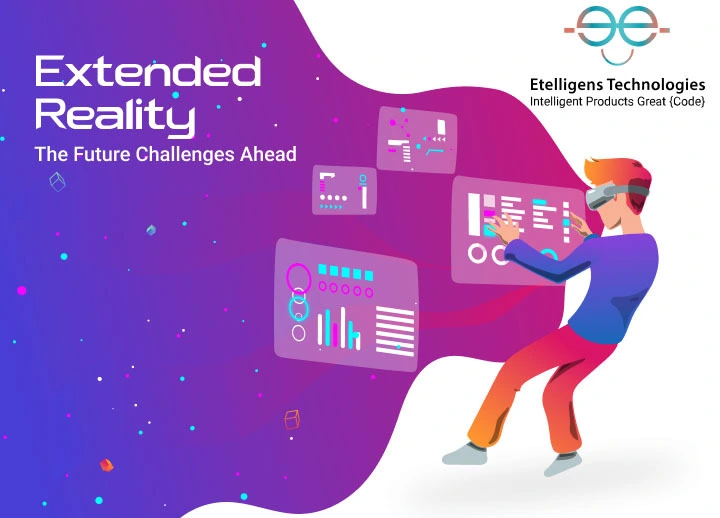As technology continues to develop at an unstoppable rate. Extended reality provides people with more advancements, allowing them to live more comfortably and efficiently. Many businesses from multiple verticals have benefited from extended reality app development. And the pace at which the Extended Reality (XR) is growing, there won’t be an industry that doesn’t utilize this tech by 2025. Also, with the Covid-19 pandemic where remote work is thriving, XR developers are playing a crucial role in shaping the work culture and the economy.
But first, you need to understand what precisely Extended Reality (XR) is? In which industries will it have the most impact, and what challenges does it pose? Then only with your team of extended reality developers can you develop a future rich extended reality application.
Let’s take a look.

What Is Extended Reality?
VR, AR, and MR all fall under the Extended Reality (XR) umbrella, comprised of augmented reality, virtual reality, and mixed reality, respectively. As a result, these technologies offer users a more engaging experience. As a whole, extended reality software development will grow at a CAGR of 57.91% to USD 397.81 billion by 2026. Let’s examine each existing technology right now to get a better picture of XR.
Now let’s look into the different industries that are fully utilizing XR and benefiting from it. And what are the challenges?
Industries Utilizing Extended Reality
Numerous companies worldwide are already taking advantage of the technology, including entertainment, healthcare, gaming, real estate, retail, and even the military. But can extended reality benefit all of these sectors? First, take a look at some of the successful extended reality applications.
Entertainment
By combining virtual reality and entertainment, XR allows consumers to virtually experience live musical performances and sports events. Video games primarily consume extended reality technology, accounting for 34% of the market. As a result, companies of that kind are doing well commercially, as their success depends heavily on providing a fully immersive experience.
Real Estate
Real estate is another sector that can benefit significantly from extended reality solutions. Using this technology, prospective tenants and customers can view properties without traveling. As a result, all parties involved save time by using it, streamlining the choosing process. In addition, XR technology allows specialists and customers to see each project from a different viewpoint, reducing the risk of mistakes and surprises.
Health
Extended Reality is beneficial in a variety of surgeries. For example, doctors can view extra details about a specific intervention through these extended reality solutions in the operating room. Using this information, they can make a better estimate about how to conduct the intervention and the problems you could encounter. Additionally, modern MRI and CT scans utilize extended reality extensively, and medical imaging is another application of this technology.
Marketing
Marketing is yet another industry that benefits significantly from XR. Organizations use extended reality to entice customers to purchase products and services by using virtual environments immersive marketing techniques. For example, a company can advertise products through XR and provide users with hands-on experiences about their products. Companies can implement this method and spend less on advertising because they can directly tell their customers what the product is like to use, rather than advertising.
Now that you know what industries benefit the most from extended reality. But extended reality developers face their own set of challenges associated with it. With cyber-attacks taking on new levels of vulnerability, the high cost of implementation XR makes it challenging for companies to enter.
Challenges of Extended Reality
The adoption of XR technologies, such as virtual reality (VR) and augmented reality (AR), by consumers and industries, can be very beneficial. However, in addition to all the benefits of XR, there are many potential challenges, and the most prominent ones are:
1- Cost
Companies utilizing XR are primarily challenged by cost concerns as the technology is costly. These are very expensive because many hardware and technologies are used to manufacture them. In addition to its cost, XR has other challenges that since the technology will not be able to expand for being too expensive, it would lead to fewer investors for the tech.
2- Hardware
Another significant challenge that companies face is developing the hardware for XR devices. It is challenging to make hardware due to the wide range of technologies, software, and components. Also, in addition to being robust, the hardware should be compact, and it should be able to process a lot of information swiftly and quickly, and it should be cheaper.
3- Privacy
Another significant challenge that comes with extended reality is the challenge of privacy. Many private details might be required to create an environment tailored to the user’s preferences on XR devices. Companies need to spend a lot of money storing such data making this technology less cost-effective. Also, users worry about the privacy of their information being stolen.
The Future Ahead
With organizations like Meta working on the metaverse, the XR tech won’t be just visuals and audio but will also include the sense of touch. These applications will give haptic feedback like many modern smartphones and game controllers. But the choice is yours as to whether you will use XR technology within your business operations or not.
Many companies already benefit from extended reality, and thousands more are on their way. However, the implementation of XR is still somewhat risky, and it requires significant investment, just like any other emerging technology. Thus, choosing an extended reality app development company with considerable expertise is essential.

One Reply to “Extended Reality: Its Challenges, Usage and Future Ahead”